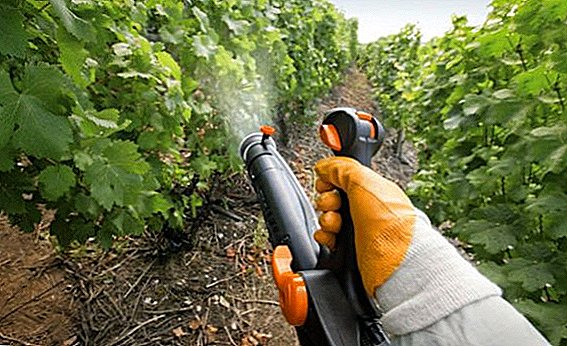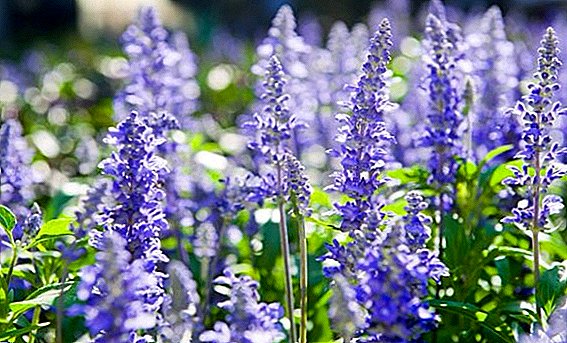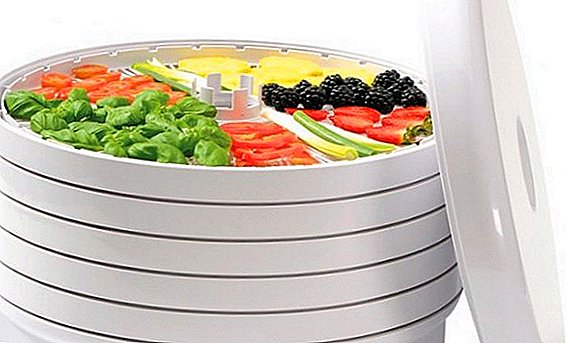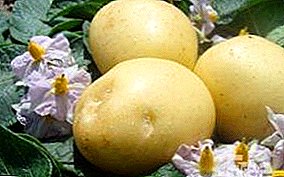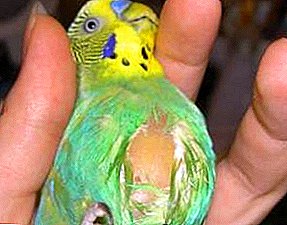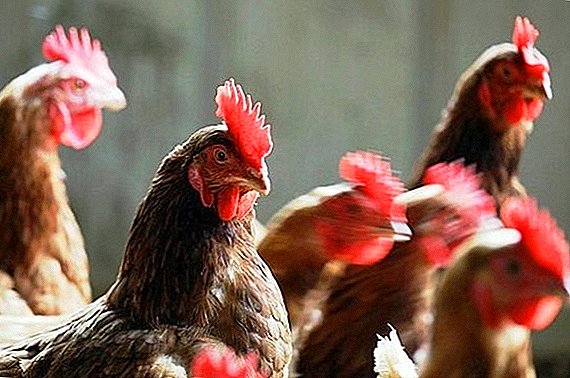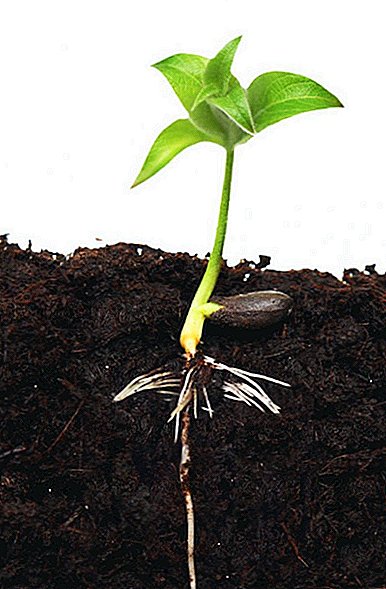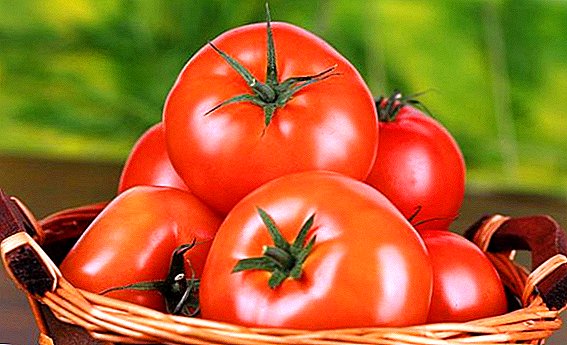 Most gardeners when choosing a variety of tomatoes have long given their preference for hybrid varieties. This is not surprising, since all other things being equal, they are more resistant to external factors, high-yielding and unpretentious.
Most gardeners when choosing a variety of tomatoes have long given their preference for hybrid varieties. This is not surprising, since all other things being equal, they are more resistant to external factors, high-yielding and unpretentious.
One of the popular hybrids is the variety "Irina f1", with the peculiarities of which we will get acquainted with.
Appearance and description of the variety
So, the tomato "Irina" refers to the hybrid varieties of early ripening, the first fruits are given 95 days after germination. Shrub determinant, the highest point of growth is usually 130 cm.  The variety is suitable for growing in a greenhouse, and for open ground.
The variety is suitable for growing in a greenhouse, and for open ground.
Fruit Characteristic
Tomatoes "Irina" grow medium size, they have a round shape, slightly flattened on top and bottom. In a state of full maturity, the tomatoes are red with smooth thin skin, the surface is not ribbed.
The pulp is dense with a distinct tomato flavor. The mass of fruits is small, about 120-130 g.
Advantages and disadvantages
Like many hybrid varieties, tomatoes "Irina" have more advantages than disadvantages:
- high yield - from 1 square meter you can collect up to 18 kg of fruits;
- early ripeness;
- high resistance to diseases and pests characteristic of tomatoes;
- excellent presentation and ability to tolerate long-term transportation.
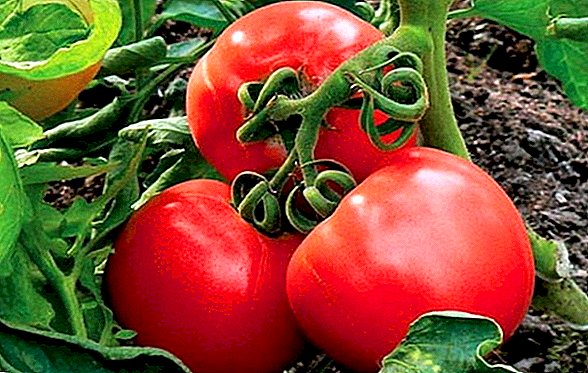
Agrotechnology
Growing tomatoes is not very difficult, but troublesome, because they require careful adherence to the rules of preparation and timing. Tomatoes "Irina f1", like all hybrid varieties, are grown by breeding seedlings from seeds.
Seed preparation, planting seeds and care for them
Seeds for seedlings sown no less than six weeks before the date of planting seedlings in the ground. Usually, the seeds of hybrids are not subjected to additional processing, disinfection and germination, like the seeds of ordinary tomatoes.
Get acquainted with such varieties of tomatoes as "Chio Chio San", "Pink Stella", "Bear's Paw", "Petrusha-gardener", "Lazyka", "Bokele", "Honey", "Countryman", "Solerosso", "Niagara", "Pink Elephant", "Rocket", "Doll Masha", "Grapefruit", "Strawberry Tree", "Korneevsky Pink".This is due to the fact that the manufacturer allegedly prepared them in the conditions of industrial production, and they are ready for sowing. However, experienced gardeners recommend disinfecting seeds in any case, if the seeds are not granulated.
To do this, they are soaked in a strong raspberry solution of potassium permanganate before planting. The solution is made at the rate of 1 cup of water per 1 g of dry manganese. Seeds in cotton are placed in potassium permanganate for 10 minutes and then washed.  After the procedure, the seeds are planted in a box with a ground for sprouting seedlings. The soil with which the box will be filled must also be decontaminated.
After the procedure, the seeds are planted in a box with a ground for sprouting seedlings. The soil with which the box will be filled must also be decontaminated.
There are different ways to do this - someone spills it with a solution of the same potassium permanganate, someone progals the soil mixture in the oven, some pour it with hot water.
Important! You can buy ready-made soil in the garden shop, then the procedure for disinfecting the soil before sowing seeds can be neglected.The soil at the time of sowing should be moist and compacted. Seeds are sown in grooves up to 2 cm in depth, at a distance of 1.5-2 cm from each other and covered with soil mixture from above. Now the future seedlings need time, warmth and light.
 Shoots can be expected, on average, after a week, in some cases - after 10 days.
Shoots can be expected, on average, after a week, in some cases - after 10 days.Watering seedlings should be careful and carried out as needed, water should not be colder than 22 ° C.
A great influence on the future harvest has timely picking seedlings. This is essentially a transplant of a plant into another container.
The essence of the picking is that in this way there is an exception of plants that have not developed enough roots, or if the seedling is affected by some disease.
Usually hybrids dive at 10-14 days after the first shoots.
Important! A plant can be dived only when there are at least two leaves on the seedlings.When transplanting should act very carefully, try not to damage the root system and the stem of the plant. Replant the seedling with a lump of earth in an individual pot. After completing the picking, the newly planted seedlings are watered with settled water.

Seedling and planting in the ground
Before planting seedlings in the ground it must be hardened. For this, containers with seedlings are first gradually taught to lower the temperature in the room: in the daytime up to + 16 ° C, at night about + 8 ° C. Then the plants are carried out to the open air, gradually increasing the residence time to a full day.
Did you know? If it is necessary to increase the drought tolerance of future tomato bushes, it is necessary at the stage of growing seedlings to water them no more than once a week.Typically, the landing in the ground occurs 50-60 days after the appearance of the first shoots. It is necessary to approach meticulously to the selection of the site on which the tomatoes will grow, since the volume of the future crop depends on it.
Tomato "Irina F1", like most other varieties, is moisture-loving, and also loves sunshine and heat, although foliage may suffer from direct sunlight.  The best for growing tomatoes is the area facing south, well ventilated, but not cold, protected from strong drafts.
The best for growing tomatoes is the area facing south, well ventilated, but not cold, protected from strong drafts.
It is also important to know what was growing on the plot to the tomatoes and, proceeding from this, to properly prepare the soil.
Radish and green lettuce are well compacted, tomatoes are well grown on the soil in which cucumbers or zucchini are grown.
However, you should categorically avoid the areas on which the vegetables of the nightshade family grew: these crops greatly deplete the soil, therefore at least three years are needed to restore it.
The soil in the selected area is cleared of weeds, loosened, treated with copper sulfate solution to destroy possible pests, then fertilized with mineral fertilizers and dug.  Tomato seedlings by the time they are planted in open ground should be at least 20 cm. Before planting, seedlings are treated with insecticides to protect them from the Colorado potato beetle.
Tomato seedlings by the time they are planted in open ground should be at least 20 cm. Before planting, seedlings are treated with insecticides to protect them from the Colorado potato beetle.
The insecticides include Agita, Marshal, Lightning, Tanrek, Mospilan, Regent, Cleanly, Fastak, Vertimek, Kemifos.The seedlings are planted in the ground in a staggered manner in pre-prepared holes: no more than 4 bushes per square meter.
Forming a bush
Despite the fact that the bush of this variety is not very high and quite stable, experienced gardeners strongly recommend tying it and individual stems. This is due to the fact that the tomato "Irina" grows very massive clusters that can damage the stem of the plant.
In order for the plant not to waste forces on the development of the green part of the bush, every week the stepsoning is carried out, that is, the removal of the emerging shoots. This will significantly increase the yield of culture.  Years of experience proves that hybrids with 2-3 branches produce fruits better. If we talk about this variety, it is recommended to form a bush of 1-2 trunks.
Years of experience proves that hybrids with 2-3 branches produce fruits better. If we talk about this variety, it is recommended to form a bush of 1-2 trunks.
To do this, with the pinching, one leaves the strongest escape, which later develops into a full-fledged branch with fruits.
Did you know? In the greenery of the tomato bush contains toxic substance solanine, which can cause allergies, itching and fever, therefore, it is better to carry out staining with gloves.
Care and watering
Further care for the brand "Irina" implies simple actions:
- soil care, loosening, mulching with sand or a special mixture;
- prevention of the appearance of pests, the use of chemical insecticides before the stage of fruiting;
- top dressing of tomatoes at the stage of fruit formation by phosphate fertilizers;
- timely and properly organized watering.
 On watering it is worth keeping your attention. Watering tomatoes should be exclusively at the root of the plant, in order to avoid moisture on the leaves. Water for irrigation can not be used cold, it is better to let it warm in the sun.
On watering it is worth keeping your attention. Watering tomatoes should be exclusively at the root of the plant, in order to avoid moisture on the leaves. Water for irrigation can not be used cold, it is better to let it warm in the sun.Some time after watering, the soil around the bushes needs to be loosened a little to avoid stagnation of water.
Pests and diseases
Much has been said that hybrid varieties of tomatoes are practically not susceptible to diseases and are not popular with pests. However, there are some exceptions that you need to know.
Tomato "Irina" is resistant to most diseases of tomatoes, but it can not be avoided by cladosporia or brown spot. Insidious fungal disease affects the leaves first, and then the fruits themselves.  Moreover, the spores of the fungus can persist in the soil and affect subsequent planting of vegetables. Effective control involves preventing the disease, tilling the soil before planting, spraying the bushes with antifungal agents, removing the affected plants.
Moreover, the spores of the fungus can persist in the soil and affect subsequent planting of vegetables. Effective control involves preventing the disease, tilling the soil before planting, spraying the bushes with antifungal agents, removing the affected plants.
Pests rarely favor this variety with their attention, but the most common and numerous still affects tomato planting with enviable diligence. This is a Colorado potato beetle.
In the fight against it, the most important rule is the treatment of seedlings before planting in open ground. Such protection will help keep the bushes unscathed until the end of the season.
Maximum fructification conditions
Many gardeners are skeptical of the so-called growth promoters, calling it chemistry, and prefer to use folk remedies to increase yields.  But now, more and more artificial stimulants are appearing on the agricultural market, which we will dwell on a bit more.
But now, more and more artificial stimulants are appearing on the agricultural market, which we will dwell on a bit more.
All vegetable crops contain a stock of phytohormones that provide growth, yield, resistance to the external environment. Of course, in every plant of hormones a limited amount is contained, and often with the influence of external factors, fruiting decreases.
To improve the growth and fruiting of tomatoes, a large number of synthetic stimulants derived from natural phytohormones have already been developed.
Each of the preparations has its own specifics: some improve yields, others accelerate ripening, and others help the plant to withstand various diseases.  Most often, when growing tomatoes, growth stimulants based on humic acids and Echinacea extract are used. These drugs in strict compliance with the instructions increase the immunity of plants and seed germination, strengthen seedlings and do not harm the quality and safety of the fruit.
Most often, when growing tomatoes, growth stimulants based on humic acids and Echinacea extract are used. These drugs in strict compliance with the instructions increase the immunity of plants and seed germination, strengthen seedlings and do not harm the quality and safety of the fruit.
Fruit use
Tomato "Irina" produces fruits with excellent external, taste and commercial qualities, thanks to which the scope of application of tomatoes of this variety is very wide:
- due to the dense skin and the small size of the fruit, these tomatoes are great for preservation;
- fleshy pulp allows you to use this variety in the preparation of tomato juices or pastes;
- The sweetish, pronounced taste makes it possible to use tomatoes "Irina" in cooking - both fresh and stewed or baked.
 We got to know more about the wonderful hybrid variety of tomatoes "Irina" and we can summarize - this variety really attracts with its high yield and endurance, but it requires painstaking care: if you pay due attention to it, you will not get a wonderful harvest.
We got to know more about the wonderful hybrid variety of tomatoes "Irina" and we can summarize - this variety really attracts with its high yield and endurance, but it requires painstaking care: if you pay due attention to it, you will not get a wonderful harvest.


